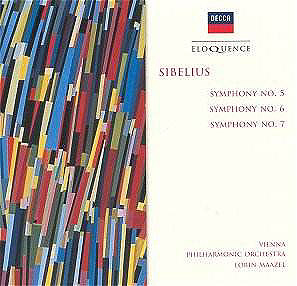 Composer: Jean Sibelius
Composer: Jean Sibelius
Works: Symphony No. 5 (1915, 1919), Symphony No. 6 (1923), Symphony No. 7 (1924)
Performers: Vienna Philharmonic Orchestra, Lorin Maazel
Recording: Sofiensaal, Vienna, March 1966 (5, 7), March-April 1968 (6)
Label: Decca
Jean Sibelius stands as a towering figure in late-Romantic music, weaving the landscape of Finnish nationalism into a symphonic tapestry that resonates with nature’s grandeur and human introspection. His symphonies, particularly the Fifth, Sixth, and Seventh, are pivotal in understanding his evolution as a composer. The Fifth, with its expansive themes and intricate structure, is often regarded as a cornerstone of his orchestral output. The Sixth, imbued with a sense of serenity and introspection, contrasts with the bold, epic nature of the Fifth, while the Seventh, in its singularity, represents Sibelius’s innovative explorations of form and harmonic language.
Lorin Maazel’s interpretations with the Vienna Philharmonic Orchestra in this collection reveal a nuanced understanding of Sibelius’s complex musical language. The performance of the Fifth Symphony, clocking in just over 27 minutes, has garnered mixed reactions for its brisk pace. Critics have pointed to an apparent rush that risks sacrificing the work’s inherent depth. However, Maazel’s approach captures the symphony’s vigorous spirit with staggering precision of ensemble and dynamic contrast. For instance, the climactic moment at 5:45 in the third movement showcases a tension that, while it may flirt with fatigue, ultimately reveals the heroism that characterizes Sibelius’s vision. The brass sections deliver their contributions with both haughtiness and heart, underscoring Maazel’s ability to balance power with delicacy.
The Sixth Symphony benefits from Maazel’s ethereal treatment of the strings and meticulous attention to detail. The recording quality, despite some vestigial tape hiss, allows for a remarkable clarity that highlights the lissom woodwind solos and the life-like character of the timpani. Each musical phrase is sculpted with care, and the interpretation leans into the symphony’s introspective qualities, inviting listeners to explore its deeper emotional currents. Comparatively, while Collins’s version (Beulah) is indeed commendable, Maazel’s reading stands out for its luminous sound and the palpable sense of space that envelops the music.
Maazel’s interpretation of the Seventh Symphony presents a fascinating study in pacing and architectural construction. The opening, which feels almost casual, gradually builds tension, a testament to Maazel’s skill in guiding the listener through the work’s sprawling landscape. The trombone and brass sections are particularly notable, executing their parts with a breadth that captures the symphony’s epic scale. While some may find Maazel’s approach less urgent than Ormandy’s, it offers a distinct perspective that emphasizes the subtleties of Sibelius’s orchestration. This recording, while not necessarily in the top echelon when compared to Koussevitsky’s revered interpretations, remains a valuable contribution to the Sibelius discography.
The recording quality achieved by Decca under Erik Smith’s production is exceptional, allowing for a listening experience that captures the full spectrum of Sibelius’s orchestral palette. The fidelity of the analog recordings, while occasionally marred by tape hiss, does not detract from the emotional weight conveyed through the performances. Each note resonates with the listener, fostering a connection to the music that is both immediate and profound.
Maazel’s interpretations of Sibelius’s Fifth, Sixth, and Seventh Symphonies are compelling and articulate, marked by a blend of precision and emotional depth. His collaboration with the Vienna Philharmonic brings an undeniable vitality to these works, making this collection a significant addition to the Sibelius canon. The performances not only illuminate the rich textures and intricate structures of Sibelius’s music but also invite a deeper contemplation of its thematic complexities. This release is a testament to the enduring power of Sibelius’s symphonic vision as realized through Maazel’s insightful direction.



